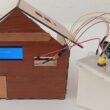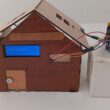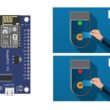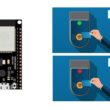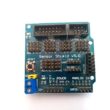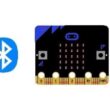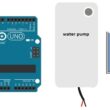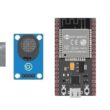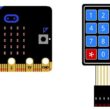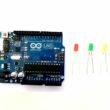Gas alarm system based on ESP32 board and MQ-4 sensor
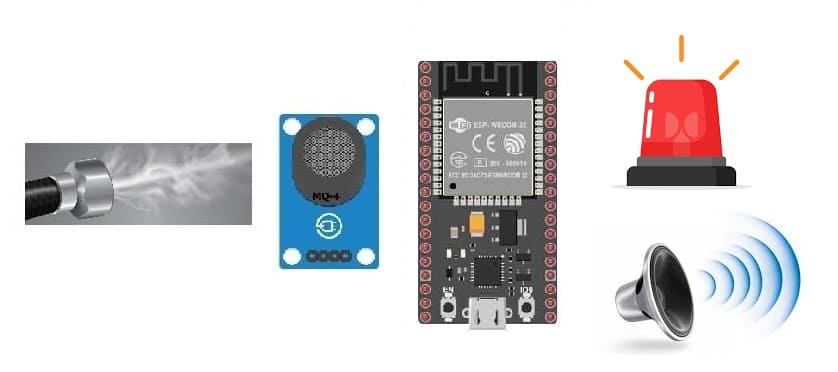
Tutorial plan
Introduction
1- How the gas alarm system works ?
2- Gas alarm system components
3- Mounting ESP32 board with MQ-4 sensor, LED and Buzzer
4- Program the ESP32 board to control the system
Introduction
A gas alarm system is a safety device designed to detect the presence of potentially harmful gases in an environment, such as carbon monoxide (CO), natural gas, propane, methane, or other combustible gases. These systems are commonly used in homes, commercial buildings, industrial facilities, and other locations where gas leaks could pose a threat to health and safety.
Here's how a typical gas alarm system works:
1- Gas Sensors: Gas alarm systems contain sensors that are capable of detecting specific types of gases. These sensors continuously monitor the air for the presence of gases, and when they detect a gas at a certain concentration level, they trigger an alarm.
2- Alarm Devices: When a gas is detected, the system activates alarm devices such as sirens, strobe lights, or audible alerts to warn occupants of the building about the potential danger. These alarms are usually loud and conspicuous to ensure they can be easily heard or seen.
3- Monitoring and Notification: In some cases, gas alarm systems are connected to monitoring services that can provide remote monitoring and notifications. This allows for immediate response in case of a gas leak, even if no one is present at the location where the alarm is installed.
4- Integration with Building Systems: Advanced gas alarm systems may be integrated with other building systems, such as ventilation systems or shut-off valves for gas lines. This integration allows for automated responses to gas leaks, such as activating ventilation to remove the gas from the building or shutting off the gas supply to prevent further leaks.
5- Maintenance and Testing: Regular maintenance and testing of gas alarm systems are essential to ensure their proper functioning. This includes periodic calibration of sensors, testing of alarm devices, and replacing batteries or other components as needed.
Overall, gas alarm systems play a crucial role in preventing accidents and protecting occupants from the dangers associated with gas leaks. They provide early warning of potential hazards, allowing people to take appropriate actions to mitigate the risks and ensure their safety.
How the gas alarm system works ?
A gas alarm system based on an ESP32 board, MQ-4 sensor, LED, and buzzer operates by monitoring the gas concentration in the environment using the MQ-4 sensor, and triggering visual and audible alarms (LED and buzzer) when the gas concentration exceeds a predefined threshold. Here's how it typically works:
1- Hardware Setup:
- ESP32 Board: The ESP32 microcontroller serves as the main control unit for the gas alarm system. It reads data from the MQ-4 sensor and controls the LED and buzzer.
- MQ-4 Gas Sensor: The MQ-4 sensor detects the presence of methane and natural gas in the air. It provides an analog output voltage that corresponds to the gas concentration.
- LED: The LED serves as a visual indicator. It can be programmed to illuminate when gas is detected.
- Buzzer: The buzzer serves as an audible alarm. It can be programmed to emit a sound when gas is detected.
2- Wiring:
- The MQ-4 sensor is connected to the ESP32 board, typically using analog input pins.
- The LED and buzzer are also connected to the ESP32 board, typically using digital output pins.
3- Data Reading:
The ESP32 periodically reads analog data from the MQ-4 sensor, which represents the gas concentration in the environment.
4- Threshold Comparison:
The ESP32 compares the analog sensor data to a predefined threshold value. This threshold value is set based on the level of gas concentration deemed to be dangerous.
5- Alarm Triggering:
- If the gas concentration exceeds the predefined threshold, indicating a potential gas leak, the ESP32 triggers the LED and buzzer.
- The LED is illuminated to provide a visual indication of the gas presence, while the buzzer emits an audible alarm to alert occupants.
6- Alert Duration and Intensity:
The duration and intensity of the LED and buzzer alarms can be programmed based on the severity of the gas concentration. For example, the alarm may continue until the gas concentration falls below the threshold, or it may escalate in intensity as the concentration increases.
7- Optional: Connectivity and Notification:
Optionally, the ESP32 can be configured to send notifications or alerts over Wi-Fi or Bluetooth to a connected device, such as a smartphone or computer. This allows users to receive alerts remotely.
Gas alarm system components
ESP32 Board:

The ESP32 is a powerful microcontroller developed by Espressif Systems. It's renowned for its integrated Wi-Fi and Bluetooth capabilities, making it a popular choice for various IoT (Internet of Things) applications.
MQ-4 gas sensor:
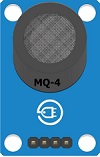
The MQ-4 gas sensor is a type of semiconductor gas sensor commonly used to detect the presence of methane (CH4) gas in the atmosphere. It belongs to a family of gas sensors known as the "MQ series," which are widely used in various applications, including industrial safety, gas leakage detection, and environmental monitoring.
LED
![]()
In an obstacle detection system, an LED (Light Emitting Diode) can be used as a visual indicator to provide feedback about the detection status. The LED can be programmed to turn on or off based on whether an obstacle is detected within a certain range.
Buzzer
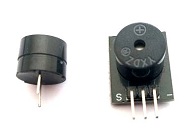
The buzzer in a gas alarm system serves as an audible alert to warn occupants of a potential gas leak
Jumper Wires:

For making temporary connections and wiring between components.
Breadboard:

A breadboard is a useful tool for creating temporary electronic circuits. It allows you to connect components without soldering.
Mounting ESP32 board with MQ-4 sensor, LED and Buzzer
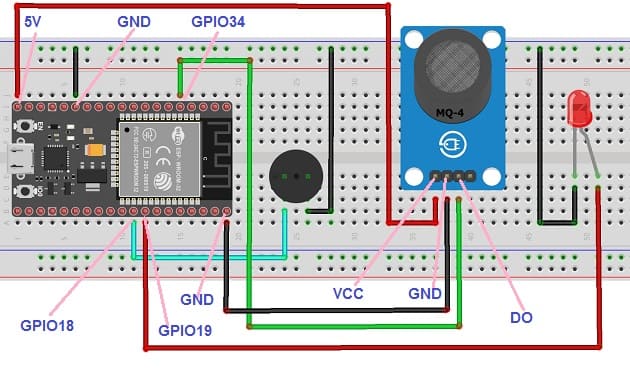
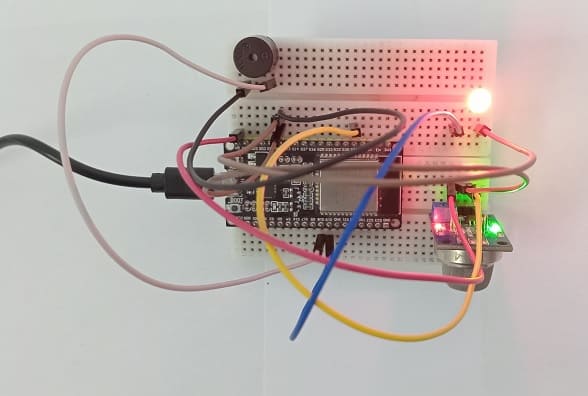
Attaching the MQ-4 sensor :
- Connect the VCC pin of the MQ-4 sensor to the 5V pin of the ESP32 board
- Connect the GND pin of the MQ-4 sensor to the GND pin of the ESP32 board
- Connect the DO pin of the MQ-4 sensor to the GPIO34 pin of the ESP32 board
Attaching the buzzer :
- Connect the (+) terminal of buzzer to GPIO18 pin on the ESP32 board.
- Connect the (-) terminal of buzzer to GND pin on the ESP32 board.
Attaching the red LED :
- Connect the negative terminal (cathode) of each LED to the ground (GND) of the ESP32 board.
- Connect a resistor between the GPIO19 pin and the positive terminal (anode) of the LED
Program the ESP32 board to control the system
To program the ESP32 board using MicroPython to control the gas alarm system with an MQ-4 sensor, LED, and buzzer, you'll need to follow these general steps:
1- Ensure that MicroPython is installed on your ESP32 board. You can find instructions for installing MicroPython on the ESP32 from the official MicroPython documentation or the manufacturer's website.
2- Write theis code :
|
1 2 3 4 5 6 7 8 9 10 11 12 13 14 15 16 17 18 19 20 21 |
from machine import Pin, ADC from time import sleep # Initialize pins gaz = ADC(Pin(34)) gaz.atten(ADC.ATTN_11DB) redled_pin=Pin(19, Pin.OUT) buzzer_pin=Pin(18, Pin.OUT) while True: gaz_value = gaz.read() <span class="hljs-comment"># Read analog value from MQ-4 sensor</span> if (gaz_value<1000) : # Check if gas concentration exceeds threshold # Activate LED and buzzer redled_pin.value(1) buzzer_pin.value(1) else: # Deactivate LED and buzzer redled_pin.value(0) buzzer_pin.value(0) sleep(0.5) <span class="hljs-comment"># Delay before next reading</span> |

